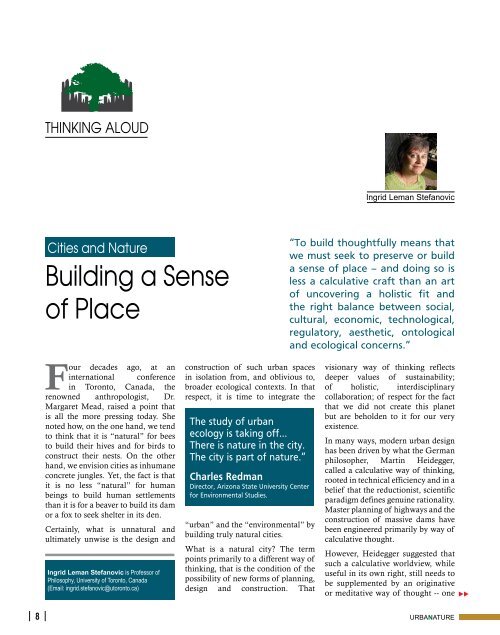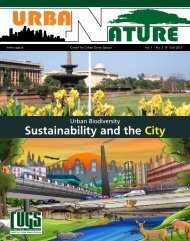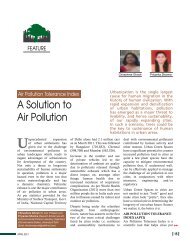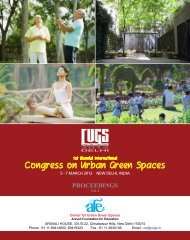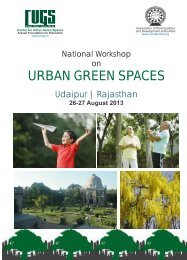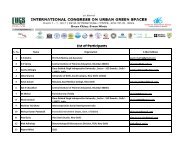Building a Sense of Place - Center for Urban Green Spaces
Building a Sense of Place - Center for Urban Green Spaces
Building a Sense of Place - Center for Urban Green Spaces
You also want an ePaper? Increase the reach of your titles
YUMPU automatically turns print PDFs into web optimized ePapers that Google loves.
Thinking Aloud<br />
Ingrid Leman Stefanovic<br />
Cities and Nature<br />
<strong>Building</strong> a <strong>Sense</strong><br />
<strong>of</strong> <strong>Place</strong><br />
“To build thoughtfully means that<br />
we must seek to preserve or build<br />
a sense <strong>of</strong> place – and doing so is<br />
less a calculative craft than an art<br />
<strong>of</strong> uncovering a holistic fit and<br />
the right balance between social,<br />
cultural, economic, technological,<br />
regulatory, aesthetic, ontological<br />
and ecological concerns.”<br />
Four decades ago, at an<br />
international conference<br />
in Toronto, Canada, the<br />
renowned anthropologist, Dr.<br />
Margaret Mead, raised a point that<br />
is all the more pressing today. She<br />
noted how, on the one hand, we tend<br />
to think that it is “natural” <strong>for</strong> bees<br />
to build their hives and <strong>for</strong> birds to<br />
construct their nests. On the other<br />
hand, we envision cities as inhumane<br />
concrete jungles. Yet, the fact is that<br />
it is no less “natural” <strong>for</strong> human<br />
beings to build human settlements<br />
than it is <strong>for</strong> a beaver to build its dam<br />
or a fox to seek shelter in its den.<br />
Certainly, what is unnatural and<br />
ultimately unwise is the design and<br />
Ingrid Leman Stefanovic is Pr<strong>of</strong>essor <strong>of</strong><br />
Philosophy, University <strong>of</strong> Toronto, Canada<br />
(Email: ingrid.stefanovic@utoronto.ca)<br />
construction <strong>of</strong> such urban spaces<br />
in isolation from, and oblivious to,<br />
broader ecological contexts. In that<br />
respect, it is time to integrate the<br />
The study <strong>of</strong> urban<br />
ecology is taking <strong>of</strong>f…<br />
There is nature in the city.<br />
The city is part <strong>of</strong> nature.”<br />
Charles Redman<br />
Director, Arizona State University <strong>Center</strong><br />
<strong>for</strong> Environmental Studies.<br />
“urban” and the “environmental” by<br />
building truly natural cities.<br />
What is a natural city? The term<br />
points primarily to a different way <strong>of</strong><br />
thinking, that is the condition <strong>of</strong> the<br />
possibility <strong>of</strong> new <strong>for</strong>ms <strong>of</strong> planning,<br />
design and construction. That<br />
visionary way <strong>of</strong> thinking reflects<br />
deeper values <strong>of</strong> sustainability;<br />
<strong>of</strong> holistic, interdisciplinary<br />
collaboration; <strong>of</strong> respect <strong>for</strong> the fact<br />
that we did not create this planet<br />
but are beholden to it <strong>for</strong> our very<br />
existence.<br />
In many ways, modern urban design<br />
has been driven by what the German<br />
philosopher, Martin Heidegger,<br />
called a calculative way <strong>of</strong> thinking,<br />
rooted in technical efficiency and in a<br />
belief that the reductionist, scientific<br />
paradigm defines genuine rationality.<br />
Master planning <strong>of</strong> highways and the<br />
construction <strong>of</strong> massive dams have<br />
been engineered primarily by way <strong>of</strong><br />
calculative thought.<br />
However, Heidegger suggested that<br />
such a calculative worldview, while<br />
useful in its own right, still needs to<br />
be supplemented by an originative<br />
or meditative way <strong>of</strong> thought -- one<br />
8 URBANATURE
Cities and Nature<br />
<strong>Building</strong> a <strong>Sense</strong> <strong>of</strong> <strong>Place</strong><br />
A natural, healthy city provides<br />
more than merely a collection<br />
<strong>of</strong> discrete initiatives, but it is<br />
a holistic phenomenon, serving<br />
as the originative condition and<br />
taken-<strong>for</strong>-granted ontological<br />
ground <strong>for</strong> humans to dwell<br />
safely and in harmony with the<br />
natural world.<br />
driven less by computing individual<br />
material things but more concerned<br />
with revealing the invisible and<br />
<strong>of</strong>ten mysterious relation between<br />
discrete entities.<br />
How is such originative thinking<br />
revealed in urban planning? The<br />
concept <strong>of</strong> the natural city certainly<br />
incorporates technical efficiency<br />
<strong>of</strong> design, but it must also seek to<br />
uncover originative meaning as<br />
well. So <strong>for</strong> instance, designing an<br />
urban core must include calculating<br />
population growth projections,<br />
developing efficient transportation<br />
solutions and managing sustainable<br />
energy use. It must rely upon new<br />
technologies, such as green ro<strong>of</strong>s, it<br />
must incorporate urban wilderness<br />
areas and it must build bicycle<br />
paths and walkways that privilege<br />
the pedestrian over polluting<br />
automobiles.<br />
But also, urban planning and design<br />
must proceed as more than simply<br />
a technical calculation <strong>of</strong> such<br />
individual functions. For instance,<br />
to build thoughtfully means that<br />
we must seek to preserve or build<br />
a sense <strong>of</strong> place – and doing so is<br />
less a calculative craft than an art <strong>of</strong><br />
uncovering a holistic fit and the right<br />
balance between social, cultural,<br />
economic, technological, regulatory,<br />
aesthetic, ontological and ecological<br />
concerns. A natural, healthy city<br />
provides more than merely a<br />
collection <strong>of</strong> discrete initiatives,<br />
but it is a holistic phenomenon,<br />
serving as the originative condition<br />
and taken-<strong>for</strong>-granted ontological<br />
ground <strong>for</strong> humans to dwell safely<br />
and in harmony with the natural<br />
world. A natural city provides the<br />
condition <strong>of</strong> the possibility <strong>of</strong> what<br />
Aristotle called “a good life.”<br />
In that regard, the natural city invites<br />
a new ethic <strong>of</strong> place. “Ethics” here is<br />
understood less as a listing <strong>of</strong> rules<br />
and principles to follow but rather,<br />
it points to the ethos <strong>of</strong> dwelling<br />
itself as the contemplation <strong>of</strong> our<br />
belonging to the natural world that<br />
gives us life. Such an ethic invites<br />
a careful listening and respect <strong>for</strong><br />
differences amongst cultures and<br />
world views. It evokes a “reverence<strong>for</strong>-life”,<br />
as humanitarian Albert<br />
Schweitzer put it, and a recognition<br />
that human beings are in the presence<br />
<strong>of</strong> a rich, living presence <strong>of</strong> nonhuman<br />
animals and ecosystems, all<br />
<strong>of</strong> which are a valuable part <strong>of</strong> our<br />
world without which our cities and<br />
we ourselves could not exist.<br />
To be sure, institutionally, we<br />
continue to separate cities from the<br />
natural world. The United Nations<br />
Environment Program (UNEP) sits<br />
independently <strong>of</strong> the United Nations<br />
Centre <strong>for</strong> Human Settlements<br />
(UNCHS). Governmental “urban”<br />
or “housing” Ministries and<br />
Departments operate separately<br />
from Parks and Natural Resource<br />
units, as if urban and wilderness<br />
areas were disparate entities.<br />
Universities teach urban planning<br />
independently from environmental<br />
or <strong>for</strong>estry programs.<br />
But the time has come <strong>for</strong> an<br />
alternative vision – one which<br />
re-integrates natural and urban<br />
environments, first in the way that<br />
we think and then institutionally,<br />
socially, and architecturally in<br />
terms <strong>of</strong> how we plan, act and build<br />
genuinely natural cities.•<br />
April 2013<br />
9


